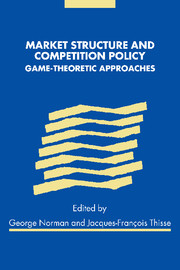Book contents
- Frontmatter
- Contents
- List of figures
- List of tables
- List of contributors
- Louis Phlips: a brief biography
- Introduction
- 1 Competition policy and game-theory: reflections based on the cement industry case
- 2 Legal standards and economic analysis of collusion in EC competition policy
- 3 A guided tour of the Folk Theorem
- 4 Predatory pricing and anti-dumping
- 5 Should pricing policies be regulated when firms may tacitly collude?
- 6 Tougher price competition or lower concentration: a trade-off for anti-trust authorities?
- 7 The strategic effects of supply guarantees: the raincheck game
- 8 Product market competition policy and technological performance
- 9 On some issues in the theory of competition in regulated markets
- 10 Modelling the entry and exit process in dynamic competition: an introduction to repeated-commitment models
- 11 Coordination failures in the Cournot approach to deregulated bank competition
- 12 How the adoption of a new technology is affected by the interaction between labour and product markets
- Index
8 - Product market competition policy and technological performance
Published online by Cambridge University Press: 22 September 2009
- Frontmatter
- Contents
- List of figures
- List of tables
- List of contributors
- Louis Phlips: a brief biography
- Introduction
- 1 Competition policy and game-theory: reflections based on the cement industry case
- 2 Legal standards and economic analysis of collusion in EC competition policy
- 3 A guided tour of the Folk Theorem
- 4 Predatory pricing and anti-dumping
- 5 Should pricing policies be regulated when firms may tacitly collude?
- 6 Tougher price competition or lower concentration: a trade-off for anti-trust authorities?
- 7 The strategic effects of supply guarantees: the raincheck game
- 8 Product market competition policy and technological performance
- 9 On some issues in the theory of competition in regulated markets
- 10 Modelling the entry and exit process in dynamic competition: an introduction to repeated-commitment models
- 11 Coordination failures in the Cournot approach to deregulated bank competition
- 12 How the adoption of a new technology is affected by the interaction between labour and product markets
- Index
Summary
Too much of anything … isn't necessarily a good thing. (The Trouble with Tribbles)
Introduction
One of the persistent strands in Louis Phlips' contributions to industrial economics is that competition policy can and should be informed by economic analysis (for example, Phlips, 1993, 1995, 1996). In this chapter I make an effort in that direction.
There is a large literature that examines the impact of R&D cooperation on technological performance. In Martin (1996), I show that R&D cooperation makes it more likely that tacit collusion will be an equilibrium strategy. Here I investigate the impact of product market competition policy on technological performance.
In a market system, firms invest in new technology and new product development because of the profit they expect to earn after discovery and development. More precisely, a firm's incentive to invest in R&D depends on the difference between the profit it earns before innovation and the profit it expects to earn after innovation.
Competition or anti-trust policy exposes firms to the possibility of fines and injunctions if they engage in prohibited conduct. But the proscriptions of competition law will not be binding constraints unless the probability that violations will be detected is sufficiently high and the penalties that follow conviction are sufficiently great. In practice, neither of these conditions is likely to be met, with the result that the effect of competition policy will be to deter and ameliorate the condemned behaviour, not to completely prevent it.
- Type
- Chapter
- Information
- Market Structure and Competition PolicyGame-Theoretic Approaches, pp. 161 - 190Publisher: Cambridge University PressPrint publication year: 2000



